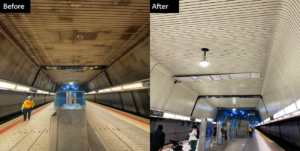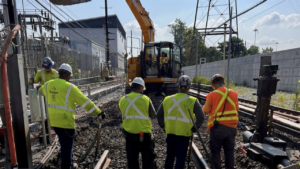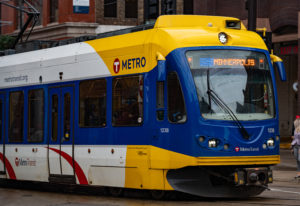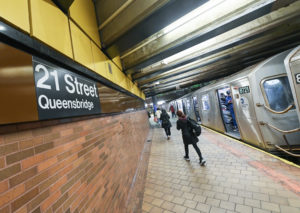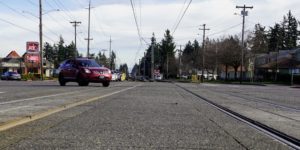Refining Approaches to Corrective and Preventive Rail Grinding
Written by Bob Tuzik, contributor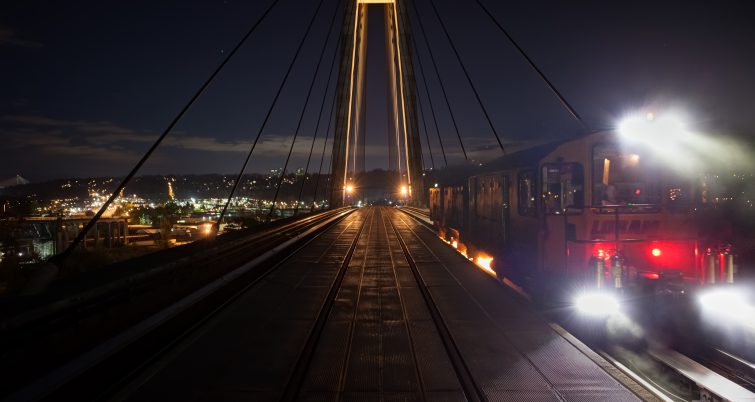
Railroads and transit systems are adopting innovative approaches to improve efficiency and productivity. As service providers look to better define grind quality.
When it comes to correcting or maintaining the profile and surface condition of rail on North American railroads, there is one primary method: rail grinding. Rail milling, an established method in other parts of the world was recently introduced in a transit application in Canada, but at present, rail grinding is the method of choice.
Freight railroads grind for two primary reasons: to maintain or manage rail shape (a fundamental aspect of wheel/rail interaction) and to minimize surface-initiated fatigue cracks that interfere with ultrasonic testing and can ultimately lead to rail defects. Transit systems grind for the same reasons, but also to control wheel/rail noise induced by rail corrugation. So, the goals of most grinding programs are to correct or maintain the desired rail profile; to remove surface damage, such rolling contact fatigue (RCF) and shells, spalls and corrugation (SSCs), which interfere with the ability of ultrasonic rail flaw detection systems to inspect the rail for internal defects.
While there are shades of gray between them, the two primary approaches have been corrective and preventive grinding. Corrective grinding typically implies the application of multiple passes with heavy metal removal at lower speeds to restore the rail shape and/or surface to acceptable conditions; preventive grinding typically implies the application of fewer passes with less metal removal at higher grinding speeds to catch degrading surface and/or profile conditions on a more frequent basis before significant damage is done.
Most grinding programs are tonnage based, with intervals determined by a range of factors, such as the hardness and cleanliness of the rail, the extent of SSCs, the existing versus desired profile, among others. While every railroad puts its own spin on grinding requirements, recommended practices for preventive grinding programs are in the range of:
— 15 – 25 MGT in sharp curves (3 degrees or greater) with rail hardness of 340 to 420 BHN;
— 30 – 50 MGT in mild curves (less than 3 degrees) and 320 to 340 BHN;
— 50 – 60 MGT in tangent track with 320 to 340 BHN, and 100 MGT with 340 to 420 BHN.
“By focusing too much on maintaining a preventive grinding mode, you can miss deeper defects.” —Wolfgang Scheoch, Speno International SA
While every railroad aspires to be in a preventive grinding mode, it’s essential to perform corrective grinding when rail conditions call for it. “By focusing too much on maintaining a preventive grinding mode, you can miss deeper defects,” Wolfgang Scheoch, Director of External Affairs, Speno International SA, told ICRI members during a panel discussion on rail grinding at the ICRI meeting in Vancouver, BC, in 2017. Preventive grinding, which typically results in very little surface material removal, only works if the rail is in a defect-free state. But defects can be missed, they can be larger than expected, develop faster than expected, and can change position over time, Schoech said.
Brad Kerchof, Director of Research and Tests at Norfolk Southern, reported on an NS study in which a number of grinding passes on an apparently clean rail section uncovered both significant RCF and a nearly 0.21-inch deep spall that was effectively invisible to ultrasonic testing due to interference from RCF at or near the rail surface. “There might be a lot of RCF out there that’s invisible until you begin to grind,” Kerchof said. And that RCF could be effectively concealing even bigger issues. The take away, he said, is that an effective grinding plan must include RCF removal wherever it impacts rail testing.
Preventative rail grinding
The goal of preventive grinding is to treat rail at regular intervals with few passes (ideally one pass) to maintain the target profile and acceptable rail surface conditions with minimal metal removal. Corrective grinding becomes necessary when RCF, SSCs or other surface conditions interfere with the ability of ultrasonic rail flaw detection systems to detect internal defects. Experience and tests have shown that corrective grinding is effective at
In one test, the TTCI analyzed five rails with surface conditions that interfered with UT testing. Optical microscopy showed that the maximum depth of 90 percent of the cracks and spalls measured in the sample rails did not exceed 0.040 inch. “This is well within the range of corrective grinding with a large production grinder,” TTCI Engineer Scott Cummings reported in Testability and Corrective Grinding Depth of Rails with Poor Surface Condition (Technology Digest 18-027) last year.
Comparison of pre- and post-grind rail profiles shows that a large production grinder can remove as much as 0.014 inch per pass at slow speeds and 0.006 to 0.008 inch per pass at more typical speeds, Cummings said. “Based on these values, three to five grinder passes could have completely eliminated the majority of cracks and spalls in the five test rails and substantially reduced the depth of any remaining surface damage, thus resulting in improved UT confidence.”
Other grinding-related research is in the offing in the near future, as well. The TTCI plans to:
— Evaluate rail grinding templates; especially, field-side relief.
— Survey grinding practices and results at switches and crossings.
— Create, evaluate and model rail profile template(s) designed specifically for turnouts.
The fact that these topics are on the TTCI’s research docket is a clear indication that Class 1s are looking for ways to improve their grinding programs. CSX is one of the Class 1s that has been honing its grinding program over the past couple years, taking an innovative approach to how it utilizes grinding equipment.
Reducing the operational footprint
CSX has initiated a joint grinding program in which it operates a 120-stone production unit followed by a 24-stone switch and crossing (S&C) grinder within the same window. The production grinder handles the bulk of the work on standard track, while the S&C machine handles specialty assets and hot spots on standard track that may need additional passes, freeing the production machine to continue operating at maximum efficiency. CSX utilizes two joint grinding teams to cover the network.
Prior to the joint grinding program, begun in 2016, CSX used a standalone S&C grinder for six months per year. Since it required its own work window and support staff the standalone S&C grinder was less effective and costlier to operate.
By operating in the wake of a production grinder, which gets high priority because of its cost to operate, the S&C grinder gets the same priority access. And by working them together, CSX has doubled the grinding program’s productivity and reduced its operating footprint (the number of track windows required) by 65 percent.
Last year, CSX incorporated the use of Loram’s Rail Inspection Vehicle (RIV), which collects rail profile and surface condition data prior to production grinding, to also inspect switches and crossings. By inspecting rail to be addressed by the production and S&C grinders, Loram is able to generate grinding plans for the out-of-face and specialty grinds with one inspection, rather than the multiple inspections / track occupations required in the past.
Prior to using the RIV, CSX performed manual inspections at specialty assets with a star gauge, then used standard patterns to grind to a standard 8-inch radius—the same shape as new rail. Using information collected by the RIV, CSX is now able is to develop a custom grinding plan with the precise patterns and number of passes needed for each specialty asset. “By going directly to our custom rail profile, which better matches the typical worn wheel profiles, we’re reducing the contact stresses by 50 to 70 percent,” said Dan Hampton, CSX manager of contract services. This reduction in contact stress should result in rail life extension for these high-cost specialty assets.
The CSX grinding program uses a tonnage-based frequency with a weighted average for different segment lengths; the grinding frequency for curves varies, depending on the degree of curvature. CSX typically grinds tangent segments at between 50 and 70 MGT. Curves are ground at 25 to 35 MGT. “If we’re grinding at 25- to 35-mgt cycles, we’re grinding tangents every other cycle,” Hampton said. But rather than just skipping tangents every other cycle, CSX and Loram created algorithms that take tonnage since the last grind and Grind Quality Index (GQI) of the rail profiles into account. If the profile has a GQI of 95 or higher with no surface conditions that need to be addressed, the planning software has an automated rule to skip it. There are, on the other hand, tangent segments that need to be ground every cycle because of tonnage, grade, signals, yard leads, etc., which cause a lot of stopping / starting, accelerating / braking , he said.
The CSX Operations Research team also developed a scheduling optimizer that assigns priority to high-tonnage, passenger and hazmat routes to ensure that segments are ground as close to the optimum cycle as possible while minimizing non-productive travel. “By using the scheduling optimizer, we cut 10 travel days, which represents hundreds of thousands of dollars, from the grinding plan,” Hampton said.
While grinding to address rail surface conditions—RCF and SSCs—is a bigger driver than profile correction, CSX has found that profile conditions are a good guide to overall rail conditions. “We tend to find poor surface conditions wherever the profile is out,” Hampton said. “But we also find poor surface conditions in locations where the profile is fine.”
A lot of SSCs occur in the approaches to switches and crossings, an area in which production grinders generally pick up the stones to prevent damage to specialty assets. S&C grinders are used to handle this. CSX determined that a minimum of 10 passes with an S&C grinder (two five-pass series consisting of two passes to gauge, two to field, one at the top) is required to remove enough metal for an inspector to determine if the SSCs were removed. An additional five to 10 passes (one or two five-pass series) may be required to completely remove them; then an additional one to three passes will be required correct the profile.
To better target SSCs, CSX developed the NavPro application, which uploads data to the grinders and displays the length and GPS coordinates of SSCs on digital track charts. “With this information, we’re able to roll right up to the spot and grind it out. If it’s more than 250 feet, we hit it with the big production grinder, then follow up with the specialty grinder with as many passes as needed to clean it,” Hampton said. “It’s much more efficient than the previous approach.”
“We went from grinding less than 5 percent to grinding 85 percent of our bridges.” —Dan Hampton, CSX
SSCs also occur on bridges. And like most railroads, CSX is wary of grinding on bridges—especially timber bridges. As a result, the railroad expanded the NavPro app to include the locations and types of bridges, whether they can be ground, and the requirements for fire protection. When the grinder operator sees a bridge coming up on the digital map, he knows what type of bridge it is and whether to grind it. And the support crew knows the fire-protection plan. “We don’t grind anything with a wood substructure, for example, but we treat a concrete ballast deck bridge just like any other right of way,” Hampton said. “Using this approach, we went from grinding less than five percent to grinding 85 percent of our bridges.”
With the ability to grind on most of its bridges, along with the effectiveness of its joint grinding program, CSX has reduced the number of SSC on the property by 60 percent per year for the past three years, Hampton said.
The next piece of the puzzle is dynamic track segmentation, which will allow the grinders to change patterns wherever the rail profile needs changing, based on pre-inspection reports and analysis. CSX is also looking into ways to correlate GQI values with rail life extension. “Will a GQI score of 80 provide the same rail life extension as a score of 90?” Hampton said. “Better understanding of the relationship between rail profile and rail life extension will allow us to make better decisions, to optimize the program and maximize safety and efficiency.”
Rail Transit: Incorporating new data streams
“With the instrumentation, that’s available, it’s possible to monitor and manage grinding with greater rigor,” said Eric Magel, Principal Engineer at the National Research Council of Canada. Comprehensive measurement of profile shape, rail surface condition, corrugation and wheel/rail-related noise is being done on a few transit systems. Bay Area Rapid Transit (BART) , for example, regularly measures rail profile, surface cracks with eddy current measurement and corrugation with a Corrugation Analyzer Trolley (CAT). With this information to work with BART and its consultants are moving beyond a typical GQI assessment.
“The current approach to GQI is limited because it set limits based only on what the grinder is capable of achieving, not on whether the profiles are actually meeting a performance requirement,” Magel said. The idea behind the GQI is to put a reasonable tolerance around the shape you’re trying to achieve. As it stands, however, 100 percent means that it’s within ±0.25 millimeters of the described shape. But if you’re a high by 0.2 mm in one spot and low at another, you can generate very different contact conditions. We’d like to tighten the tolerances to indicate that you’re at 100 percent if you’re spot on, short of that, you might be at 80 or 70 percent”.
The NRC, in collaboration with the University of Manitoba and Advanced Rail Management Corp., has begun a project to evaluate how to better determine when rail shape associated with the grinding quality index (GQI) is good enough, and whether there’s a reasonable return on investment to improve it from a 70 to an 80, or better. The consortium is looking to migrate away from the standard GQI toward three related indices: a profile quality index, a surface quality index (which could be called an RCF index), and a corrugation index.
Magel and Kevin Oldknow, Associate Dean – Faculty of Applied Sciences at Simon Fraser University, laid out their ideas on “Quality Indices for Managing Rail Through Grinding” at the 11th International Conference on Contact Mechanics and Wear of Rail/Wheel Systems, in September of last year. They proposed three related indices in place of the current GQI:
- Profile Quality Index (PQI), which replaces the former GQI, to measure and evaluate efforts to move the rail profile toward the shapes prescribed by the rail grinding templates.
- Surface Damage Index (SDI) to measure a grinding program’s effectiveness in:
— immediately or progressively removing rail surface damage and expose clean material beneath;
— minimizing the probability of an RCF-caused broken rail;
— facilitating reliable ultrasonic testing.
- Rail Corrugation Index (RCI), which measures the program’s effectiveness at removing corrugation that contributes to noise, vibration and track deterioration. RCI will apply chiefly to rail transit systems.
“We saw a 73 percent reduction in customer noise complaints, last year.” —Greg Shivy, BART
Together, the PQI, SDI, and RCI indices can provide the basis for an equivalent grinding index (EGI), which in addition to the three indices would also take tonnage, track geometry, rail metallurgy and friction conditions into account, they said. Initial efforts will focus on transit, since a few of them are already collecting the necessary rail profile, surface and corrugation data to support all three indices. Acoustic data is also proving to be a useful variable in identifying the presence of corrugation and the effectiveness of grinding programs to remove it.
The Bay Area Rapid Transit (BART) system is a pioneer in using acoustic data to guide its corrective grinding program. BART combines acoustic data collected by microphones on the trailing ends of revenue trains with data from a Corrugation Analyzer Trolley to pinpoint locations that need to be ground. BART uses CoreTracker, a proprietary software utilized by ATS Consulting, BART’s acoustics consultant, to look at noise data in a graphical form, and to generates reports that identify priorities based on the decibel level.
“We tend to see roaring corrugation at frequencies between 400 and 600 Hertz,” said Greg Shivy, BART’s principal track engineer – maintenance and engineering. Noise levels, along with complaints from passengers and nearby residents, increase in tunnels and aerial structures, and at speeds above 50 mph.
Like most transit systems, BART gets precious little time for maintenance – about 90 minutes during the week and up to 4 hours on weekends. Near term, much of the grinding effort is spent chasing corrugation. But it has been effective. “We saw a 73 percent reduction in customer noise complaints, last year,” Shivy said.
But addressing hot spots is only one driver of the grinding plan. BART only recently completed a migration of its fleet from a cylindrical wheel shape to a conical BT3 wheel profile. New “interim” rail profiles have been designed and applied to correspond with the changing wheel shapes. Using a pair of 12-stone in-house transit grinders, BART plans to grind nearly 4,000 pass miles across the 125-route-mile system to achieve the desired rail profile over a four-year period.
About 1,000 pass miles were completed last year. And by the end of this year, BART will have completed the interim rail profile across the system. It will then go back and install the final profile.
With all the wheels converted to the new cylindrical profile as of January of this year, BART start with a clean slate. “We’re going to look closely at corrugation growth rates to see how they correlate to curve radius, speed and track types,” Shivy said. “It will be interesting to see how corrugation growth rates change with the new wheel and rail profiles over time.”
And with the corrugation issues on the run, BART will be able to get its grinders over the system more quickly with less metal removal to address RCF and other surface conditions. A more efficient grinding program coupled with comprehensive pre- and post-grind measurement of surface conditions will go a long way toward improving conditions at BART and educating the industry, overall.
“The ability to measure rail profile, wear, surface cracks, and corrugation is enabling us to take a more scientific approach to rail grinding,” said Gordon Bachinsky, president of Advanced Rail Management Corp., which manages BART’s rail measurement and grinding programs. Monitoring noise levels, as is done at BART, will not only identify problem areas, but verify that they’ve been addressed, he said. “These improvements, along with more rigorous requirements for surface finish, will push grinding, and possibly milling, into an exciting new era.”

